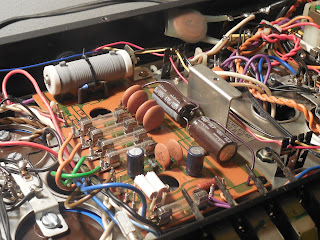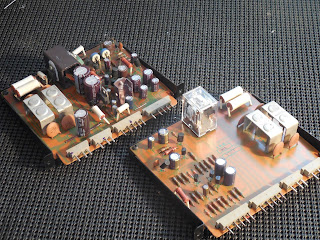Harman Kardon 250 Stereo Tube Power Amplifier
03/04/2016 Update*
http://marantzhallo-fi.blogspot.com/2016/03/harman-kardon-250-rectification-close-up.html
Here we’ve got a vintage-audio members Harman Kardon 250 Tube Power Amplifier. Running of a quad of 6L6 and front end 6CG7 signal gain tubes coupled to 32<tap output transformers. The 250 amplifier was built with a all copper chassis, something you don’t see very often, or at least under 1K$. The 250 can be ran bridged potentially or as an independent, built 1959 the original tubes were still in place with only a little oxidization occurring on the chassis. For this rebuild all resistors, capacitors including filtering and multi-section along with a new tube compliment by Electro-Harmonix were selected.
03/04/2016 Update*
http://marantzhallo-fi.blogspot.com/2016/03/harman-kardon-250-rectification-close-up.html
Here we’ve got a vintage-audio members Harman Kardon 250 Tube Power Amplifier. Running of a quad of 6L6 and front end 6CG7 signal gain tubes coupled to 32<tap output transformers. The 250 amplifier was built with a all copper chassis, something you don’t see very often, or at least under 1K$. The 250 can be ran bridged potentially or as an independent, built 1959 the original tubes were still in place with only a little oxidization occurring on the chassis. For this rebuild all resistors, capacitors including filtering and multi-section along with a new tube compliment by Electro-Harmonix were selected.
The first area addressed was the power supply and rectification stages. The rectification consists of tiered silicon diode rectifies and large C13/14 smoothing paper-electrolytic capacitors, these were replaced with built up 100+47MFD/450V Nichicon TVX axial capacitors. The recitifcation stage if examine is kinda unique; in effect its utilizing a 1/2 Wave rectification stage on each side of the C13/C14 smoothing capacitors working out to about 200V+ across each cap in its energize/energize phasing thus working as a voltage double circuit. AC taps consists of a multi-tailed 8(8)MFD/450V paper electrolytic which was replaced with two 10MFD/450V Nichicon TVX capacitors. The large multi-section filter capacitor was disconnected from the chassis to which the grounding is shared. Nichicon low impedance, high temperature (105C) PW capacitors were installed and braced to the chassis in place of the multi-section, the 6.8K and 68 OHM 1W and 2W carbon composite resistors were replaced with flame-proof MOX type 1 and 2W resistors.
03/04/2016**
In an update blog posted we visited the rectification stage with new Silicon Diodes and 47PF Bypass WIMA films
In an update blog posted we visited the rectification stage with new Silicon Diodes and 47PF Bypass WIMA films
Moving onto the low signal 6CG7 tubes circuit, the 6CG7 is a twin triode configured miniature packaged tube. Very similar to the 12AU7 layout wise.
Small Signal Process
All carbon composites were removed and replaced with carbon film Vishay resistors. i want to note the about 80% of the carbon composites pulled were grossly off their rating, with an average slew of 20%<. As has been discussed their are some variations from the actual schematic released (below). All the 47/100 and 330PF ceramic capacitors were replaced with high grade WIMA pp type film capacitors and all carbon composite resistors replaced with Vishay carbon film resistors. Each 330/47PF are paralleled. Each balance output pot was cleaned with Caig D5 and adjusted.
Small Signal Process
All carbon composites were removed and replaced with carbon film Vishay resistors. i want to note the about 80% of the carbon composites pulled were grossly off their rating, with an average slew of 20%<. As has been discussed their are some variations from the actual schematic released (below). All the 47/100 and 330PF ceramic capacitors were replaced with high grade WIMA pp type film capacitors and all carbon composite resistors replaced with Vishay carbon film resistors. Each 330/47PF are paralleled. Each balance output pot was cleaned with Caig D5 and adjusted.
SCHEM UPDATES
Plate (#1 of V2 6CG7) R26 56K to 280VAC tap (not) R27(1M)
R30 820OHM parrallel W/ 47PF.
Driver Stage Output
The output stage consists of 2 6L6GC tubes per channel, matched. The 6L6 is a quality power tube typically seen in 25+ watt tube amplifiers, consisting of a beam-pentode large envelope package tied to (<32Ohm) output transformers. The push-pull topography is set to a tetrode-bias configuration capable of rated 25W (the 250 can be ran parallel for up to 50W) at 1%THD.
The large original coupling film capacitors rated .047MFD were upgraded to .22MFD high grade Solen Polypropylene film capacitors with the 180 and 330OHM carbon composites replaced with flame-proof MOX resistors. Below is the 250 getting the balance to equal. no bias concerns need to be addressed as this is a tied cathode tetrode set bias arrangment. Balance is set;
The large original coupling film capacitors rated .047MFD were upgraded to .22MFD high grade Solen Polypropylene film capacitors with the 180 and 330OHM carbon composites replaced with flame-proof MOX resistors. Below is the 250 getting the balance to equal. no bias concerns need to be addressed as this is a tied cathode tetrode set bias arrangment. Balance is set;
Audio Notizen
Balance (Null) beim widerstand R6 und R21 (100K fur 2.23Vdc)
R6 beim punkten (r4/r7 widerstand) fur gleich Vdc (2.7V(3.5<))





















































